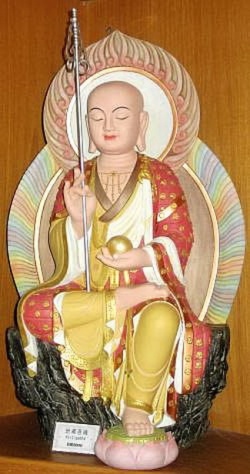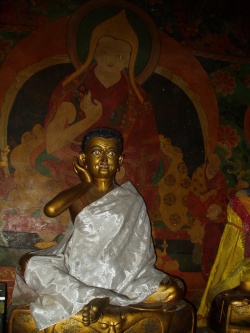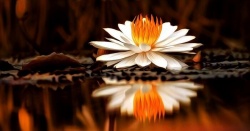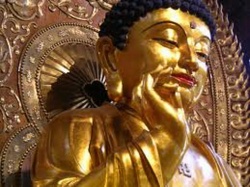Difference between revisions of "Zhenyan"
| Line 1: | Line 1: | ||
| − | [[File:Es35.jpg|thumb|250px|]] | + | [[File:Es35.jpg|thumb|250px|]]<nomobile>{{DisplayImages|673|3882|398}}</nomobile> |
Latest revision as of 15:46, 23 December 2015
ZHENYAN Buddhism is a form of Vajrayāna Buddhism that flourished in China from the seventh to the twelfth century.
The term zhenyan is a translation of the Sanskrit word mantra and literally means "real word."
The school is also called Mijiao (esoteric teaching) to distinguish it both from all other forms of Buddhism, which are regarded as exoteric, and from Indo-Tibetan Vajrayāna.
The Chinese translation of mantra by the word zhenyan underscores the importance of a realized ontology.
Zhen designates the real, apprehended through words, meditation, and action: it is reality realized.
http://www.academicroom.com/humanities/religion/buddhist-studies/buddhist-sects/zhenyan www.academicroom.com
Zhenyan Buddhism is a form of Vajrayāna Buddhism that flourished in China from the seventh to the twelfth century. The term zhenyan is a translation of the Sanskrit word mantra and literally means "real word."
The school is also called Mijiao (esoteric teaching) to distinguish it both from all other forms of Buddhism, which are regarded as exoteric, and from Indo-Tibetan Vajrayāna.
The Chinese translation of mantra by the word zhenyan underscores the importance of a realized ontology. Zhen designates the real, apprehended through words, meditation, and action: it is reality realized.
Although the term zhenyan is conventionally used to designate sectarian lineages during the Tang (618–907) and Song (960–1278) dynasties, it may also indicate Tantric precursors of the organized lineages and the continued presence of Zhenyan elements in other sects and in popular cults.
History
Buddhism spread across Asia on two levels: clerics with a theological bent missionized the literate elite while healers and wonder-workers ministered to the peasants.
Early proto-Tantric materials in China appear at both levels, although their application is largely associated with wonder-workers. Zhu Lüyan translated the first text containing dhāraṇīs, the Modengqie jing (T.D. no. 1300), in 230 ce, yet there is little evidence that it aroused interest at the Wu court in the South.
Fotudeng (d. 348) worked among the people and served the rough latter Zhao emperors Shi Luo (r. 330–333) and Shi Hu (r. 333–348) with a repertoire of mantras and dhāraṇī s. Like later Zhenyan masters, he used ritual to bring rain, to make military prognostications, to heal, and to influence politics.
During the Six Dynasties period (221–584), the magical use of mantra and dhāraṇī found greater acceptance in North China while other Buddhist traditions dominated the literary culture of the South.
The unification of China under the Sui (584–618) and Tang dynasties wedded the interests, culture, and family lines of the barbarian North with those of the Han South. Meanwhile in India, Tantric ritual,
spurned earlier as heterodox by the Buddhist establishment, was being codified and blended with Mahāyāna theology, resulting in the formation of the Vajrayāna.
During the first century of Tang rule other Buddhist schools held sway, and Daoists were patronized by emperors who made much of the fact that they bore the surname (Li) of the sage Laozi.
Tantric teachings remained eclipsed until the arrival of Śubhākarasiṃha (Shanwuwei) in 716 and his translation of the Mahāvairocana Sūtra (T.D. no. 848).
Vajrabodhi (Jin'gangzhi) and his disciple Amoghavajra (Bukong) arrived in 720 and produced two selective translations of the Sarvatathāgatatattvasaṃgraha (T.D. no. 866, 865).
For the next fifty years the wonder-working abilities of these ācārya s (teachers) and the prestige of their newly imported teachings bolstered the school until, under Amoghavajra and Emperor Daizong (r. 762–779), Zhenyan replaced Daoism as the dominant religious force among the elite.
During the Tang there were two closely related Zhen-yan lineages. Śubhākarasiṃha and his disciple Yixing concentrated on the Mahāvairocana Sūtra and its Commentary (T.D. no. 1796) and on the Susiddhikāra Sūtra (T.D. no. 893).
Vajrabodhi, Amoghavajra, and Amoghavajra's disciples Hanguang, Huiguo, and others concentrated on the Sarvatathāgatatattvasaṃgraha and also incorporated teachings associated with the Mahāvairocana Sūtra.
Thus, each lineage had a characteristic textual emphasis. Only the best disciples were initiated into both. Amoghavajra's synthesis was the most influential, although the lineage and teachings of Śubhākarasiṃha continued to be transmitted.
Both lineages had links to non-Esoteric sects; that of Śubhākarasiṃha has great influence in Tiantai, while that of Vajrabodhi developed links to Huayan.
A similar situation developed in Japan as the Shingon and Tendai Esoteric lineages (Tōmitsu and Taimitsu, respectively) interacted with each other and with other sects.
Following Amoghavajra's death in 774 his disciples continued to perform rituals in the Imperial Chapel, at the Green Dragon and Da Xingshan temples in Chang'an, and at the Golden Pavilion on Mount Wutai.
At the beginning of the ninth century Japanese clerics such as Saichō (767–822), the founder of Tendai, and Kūkai (774–835), founder of Shingon and disciple of Huiguo, studied the teachings in China.
Source
http://www.encyclopedia.com/article-1G2-3424503431/zhenyan.html



